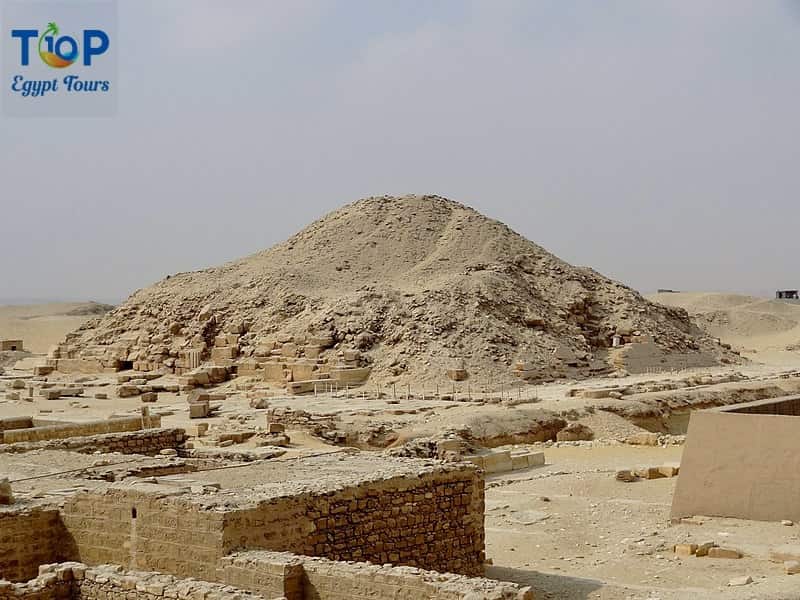The Pyramid Complex of King Unas
The Pyramid of Unas is an ancient Egyptian archaeological site located in Saqqara, near Cairo, Egypt. It is dedicated to Pharaoh Unas, the last ruler of the Fifth Dynasty during the Old Kingdom period of ancient Egypt. This article explores the key facts about the Pyramid Complex of Unas and provides insight into the historical and architectural significance of the pyramid itself.
In this article, we will uncover for you the Pyramid of Unas with Top Ten Egypt.
Pyramid of Unas:
The centerpiece of the Pyramid Complex of Unas is the pyramid itself. It is a step pyramid, similar to the earlier pyramids of the Third and Fourth Dynasties, but smaller in size. The Pyramid of Unas has a base length of approximately 57 meters (187 feet) and a current height of around 43 meters (141 feet). It was constructed using limestone blocks and features a smooth outer casing, which has mostly eroded over the centuries.
Pyramid Texts:
One of the most significant aspects of the Pyramid of Unas is the presence of the Pyramid Texts. These are ancient Egyptian religious texts inscribed on the walls of the pyramid’s burial chamber and corridors. The Pyramid Texts are considered to be the oldest known religious writings in ancient Egypt and provide valuable insights into Egyptian beliefs about the afterlife and the pharaoh’s journey to the realm of the gods.
Burial Chamber:
Within the Pyramid of Unas, there is a burial chamber where the sarcophagus of Pharaoh Unas was originally placed. The chamber is reached through a series of corridors and passages. The walls of the burial chamber are adorned with hieroglyphic inscriptions and scenes depicting religious rituals and offerings to assist the pharaoh in his journey to the afterlife.
Mastaba Tombs:
The Pyramid Complex of Unas also includes several smaller tombs called mastabas. These tombs were built for the nobles and officials associated with the pharaoh. The mastabas consist of rectangular structures with flat tops and sloping sides. They contain burial chambers and chapels where offerings and rituals were conducted to ensure the eternal well-being of the deceased.
Causeway and Valley Temple:
It features a causeway and a valley temple, which are part of the funerary complex. The causeway is a raised walkway that connects the pyramid to the valley temple, located near the Nile River. The valley temple served as a place for purification and preparation of the pharaoh’s body before the burial. It also facilitated the ritual procession of the pharaoh’s burial procession from the Nile to the pyramid.
Historical Significance:
It is historically significant as it represents the culmination of architectural and religious developments during the Fifth Dynasty. It marks the transition from the large pyramids of earlier dynasties to the smaller pyramids of the later periods. The Pyramid Texts found within the pyramid provide valuable insights into ancient Egyptian funerary beliefs and rituals.
Preservation and Restoration:
Over the centuries, the Pyramid Complex of Unas has suffered from natural erosion and human activities. However, efforts have been made to preserve and restore the site. Restoration projects have aimed to stabilize the pyramid’s structure, repair damage, and protect the inscriptions and artwork within the burial chamber.
In conclusion, the Pyramid Complex of Unas, with its pyramid, burial chambers, mastabas, and associated structures, offers a glimpse into the funerary practices and religious beliefs of ancient Egypt. The presence of the Pyramid Texts within the pyramid provides valuable insights into the spiritual journey of Pharaoh Unas and the afterlife in ancient Egyptian culture. The complex stands as a testament to the architectural achievements and cultural legacy of the Old Kingdom period. an ancient Egyptian archaeological site located in Saqqara, near Cairo, Egypt. It is dedicated to Pharaoh Unas, the last ruler of the Fifth Dynasty during the Old Kingdom period of ancient Egypt. This article explores the key facts about the Pyramid Complex of Unas and provides insight into the historical and architectural significance of the pyramid itself.



Comment (0)